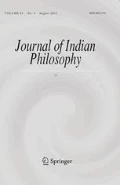Abstract
When somebody speaks metaphorically, the primary meanings of their words cannot get semantically connected. Still metaphorical uses succeed in conveying the message of the speaker, since lakṣaṇā, a meaning-generating faculty of language, yields the suitable secondary meanings. Gaṅgeśa claims that lakṣaṇā is a faculty of words themselves. One may argue: “Words have no such faculty. In these cases, the hearer uses observation-based inference. They have observed that sometimes competent speakers use the word w in order to mean s, when p, the primary meaning of w does not make any semantic sense. In all such cases, s is actually related to p. After having observed this, when the hearer hears the utterance of w, and realizes that w’s primary meaning p is semantically unfit for the sentence-meaning, they infer on the basis of their prior observation that ‘the competent speaker must mean s by uttering w’. Thus lakṣaṇā becomes a success.” This apparently well-argued reduction does not stand the critical examination; neither in Gaṅgeśa’s framework, nor even in the general theory of language. For one can compose and interpret potentially infinite novel sentences based on lakṣaṇā while the observational inferences one can make are finite. Gaṅgeśa says very clearly that as far as the secondary meaning is concerned, no prior observation is required. This paper will argue that not only does language yield secondary meanings through lakṣaṇā, but it also restricts the use of secondary meanings; for one cannot mean just anything by saying something. Lakṣaṇā is a creative function with infinite potential within the limits set up by the language faculty.
Similar content being viewed by others
References
Chakrabarti, A. (1992). On knowing by being told. Philosophy East and West, 42(3), 421–439.
Chomsky, N. (1965). Aspects of the theory of syntax. Cambridge: MIT.
Chomsky, N. (1969). Current issues in linguistic theory. The Hague: Mouton.
Das, N. (2011). Lakṣaṇā as inference. Journal of Indian Philosophy, 39(4–5), 353–366.
Dowty, D. R., Wall, R. E., & Peters, S. (1981). Introduction to Montague semantics. Dordrecht: D. Reidel Publishing Company.
Ganeri, J. (2006). Artha: Meaning. New York: Oxford University Press.
Guha, N. (2008). Arthāpatti: A critical examination. Journal of Indian Council of Philosophical Research, XXV(4), 107–133.
Jha, D. (1971). Mīmāṃsāślokavārttika of Kumārilabhaṭṭa. Darbhanga: Kameswar Simha Darbhanga Sanskrit University.
Kasturirangan, R., Guha, N., & Ram-Prasad, C. (2011). Indian cognitivism and the phenomenology of conceptualization. Phenomenology and the Cognitive Sciences, 10(2), 277–296.
Kripke, S. (1985). Speaker’s reference and semantic reference. In A. P. Martinich (Ed.), The philosophy of language. Oxford: Oxford University Press.
Matilal, B. K. (1990). Logic, language and reality. Delhi: Motilal Banarasidas Publishers Private Limited.
Saha, S. (2009). Fusion epistemology. Kolkata: Jadavpur University.
Śāstrī, P. B. (1968). Bhāṣāpariccheda of Viśvanātha with Muktāvalī commentary of Viśvanātha and Muktāvalī-saṃgraha subcommentary of Pañcānana Bhaṭṭācārya Śāstrī. Kontai: Satinath Bhattacharya.
Searle, J. R. (1985). Metaphor. In A. P. Martinich (Ed.), The philosophy of language. Oxford: Oxford University Press.
Stern, J. (1983). Metaphor and grammatical deviance. Noûs, 17(4), 577–599.
Śukla, S. N. (1936). Nyāyamañjarī of Jayantabhaṭṭa. Jayakrishna Das Haridas Gupta. Benares: The Chaukhamba Sanskrit Series Office.
Tarkavagish, K. (1990a). Tattvacintāmaṇi of Gansesa Upadhyāya (Vol. II, Part 1). Chaukhamba: Chaukhamba Sanskrit Pratishthan.
Tarkavagish, K. (1990b). Tattvacintāmaṇi of Gansesa Upadhyāya (Vol. IV, Part 2). Chaukhamba: Chaukhamba Sanskrit Pratishthan.
Tarkavagish, K. (1990c). Tattvacintāmaṇi of Gansesa Upadhyāya (Vol. II, Part 2). Chaukhamba: Chaukhamba Sanskrit Pratishthan.
Author information
Authors and Affiliations
Corresponding author
Rights and permissions
About this article
Cite this article
Guha, N. Lakṣaṇā as a Creative Function of Language. J Indian Philos 40, 489–509 (2012). https://doi.org/10.1007/s10781-012-9166-z
Published:
Issue Date:
DOI: https://doi.org/10.1007/s10781-012-9166-z




